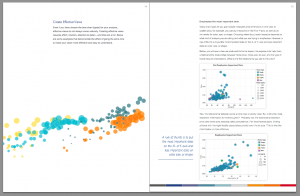As a content marketer, you might be more of a writer-who-spends-spare-cash-on-new-releases-creative-type than a spend-your-free-time-writing-code-in-the-basement-type, and that’s okay. Content marketers are like the ice cream flavors to a web developer’s ice cream maker. But there’s an odd little thing located at the cross-section of web developing and content marketing, and it’s called metadata.
You don’t have to know HTML code, be a web developer, or even a computer geek to understand and use metadata, and this is great news because, as a content marketer, you should be aware of metadata and strive to incorporate it into your content marketing SEO strategy.
Let’s Begin with the Basics: What Is Metadata?
With its similarity to metaphysics, it’s only natural for the word “metadata” to conjure up panicky flashbacks of trying to meet the tall order of reading and understanding Socrates, Plato, Aristotle, Kant, and others in that introductory philosophy course you had to take freshman year of college.
Stop worrying! Put those finals-related-flashback-jitters on hold. Take a deep breath and relax because metadata is not nearly as complicated!

Instead of attempting to describe the nature of reality (which is what metaphysics does), metadata should attempt to describe the nature of your content.
Metadata Defined
Yes, at first glance, the term metadata is a little frightening. It comes from two root words: meta, an adjective that means self-referential and data, a noun that refers to collected facts and statistics. Together the two root words make metadata, which according to Merriam-Webster is “data that provides information about other data.”
I know the concept still seems complicated, but bear with me, and you’ll soon see it’s not so bad.
Metadata Explained
In terms of content marketing, the dictionary’s definition of metadata is only slightly helpful. Before you can put metadata to work for your content marketing SEO strategy, you need to understand what it really is.
So, what is metadata in terms of content marketing?
Basically, metadata refers to the information about your web content that’s provided by a variety of meta tags. These meta tags are included within the HTML of each page of content on your website. They are not visible on your webpage to average web surfers, but web crawlers and search engines use them to find, identify, categorize, rank, and display search results. Meta tags show search engines how to display your website’s title and description in search results. Google even uses metadata to populate its coveted featured snippet search results.
Metadata provides a set of instructions to web crawlers, and these instructions tell them how to deal with your web pages. Metadata will also help you and the search engines organize all your content.
What Does Metadata Do?
Imagine a library with no alphabetization and no Dewy Decimal System. It’s messy, right? You probably wouldn’t be able to find anything.

Metadata is like a card catalog (remember those?) for digital content. It helps search engines and it helps your website. In addition to identifying page titles and descriptions, metadata creates an organizational system. Specifically, metadata generates a taxonomy (Uh-oh, not another million-dollar-word!) within your content. This is just a fancy way of saying that metadata helps to create a hierarchical organizational scheme (That sounds fancy, too.) to identify, sort, and organize web content.
Like the Dewey Decimal System organizes library materials into categories (biography, social science, natural science, philosophy, literature, and arts), metadata can help you organize your web content into the categories that work for you.
Without metadata, every bit of content on your site would be unidentifiable, unfindable, unrelatable, and completely disorganized. In a world with no meta tags, Amazon would be like a basement in a house where you lived for 50 years and never threw away (or donated #sustainability) anything. You wouldn’t be able to find the things you were looking for, and you would be swamped in stuff you didn’t need. On an Amazon without metadata, you would have to wade through millions of pages of junk, tech gadgets, tools, furniture, beauty products, and snacks before you found the dog bed you wanted to order.
Meta tags make it possible for websites like Amazon (and your site) to organize content into nifty, intuitive, easy-to-search categories. Meta tags are the reason why you can shop for a pair of shoes on Amazon in a category for apparel and then narrow the results with filters for size, color, brand, materials, and other features.

Metadata can also connect separate bits of content on your website, identifying them as related. This is how Amazon is able to offer up a variety of suggestions for similar sneakers to the ones you’ve demonstrated interest in, compare their features, and direct you to the items people like you have ultimately ended up purchasing.
I know, I know. You’re not Amazon. (Unless you are, and in that case, hello Jeff Bezos. Thank you for reading.) So, what can metadata do for all the non-Amazon websites of the world wide web?
In addition to increasing organization, it can improve your SEO.
How Does Metadata Impact Content Marketing SEO?
Metadata will increase the findability of your website and the relevance of all the content it contains – whether you’re selling shoes, dog beds, or services or distributing decorating tips, recipes, and good ideas. Increased findability and simplified searchability are precisely why metadata is a crucial component of search engine optimization.
As stated above, metadata also improves content organization. A well-organized site isn’t just important for e-commerce. It’s essential to all online content. Your impeccable organization will improve the user experience on your site, making it easier to navigate and more valuable to your audience. With a perfectly designed system of meta tags, you can quickly categorize your blog posts, video content, event announcements, press mentions, social media, and more.
As a result, properly assigned meta tags will increase the value (in terms of SEO impact) of every piece of content on your website.
What Does Metadata Have to Do with the Job of a Content Marketer?
I know what you’re thinking. “I’m a content marketer. I write content and come up with creative ideas. Leave the meta tags or whatever to the developers.”

Well, metadata management – especially when you’re hoping it’ll boost your SEO strategy – is a team effort between web developer(s) and content marketing strategist(s). So, at least part of metadata management is in the job description of a content marketer.
Content marketers should work with their web development team to create a set of metadata guidelines.
How to Create Metadata Guidelines
First, gain a thorough understanding of the different types of meta tags available to you. Also, ask your web developer for a rundown of the UX strategy currently employed on your website. A content marketer will then need to put on their own user-hat or interview actual website users to become familiarized with the way the audience navigates the website and the types of terms that would be most important to include in a new categorization system.
It’s also a smart idea to talk with the higher-ups and stakeholders in your company to ask about long-term goals for product and service offerings, expansion, and pivots. With an eye on your company’s future, you can establish a metadata system that will continue to serve you (with minimal changes) for the long-haul.
Next, work up a list of the most popular keyword terms that users associate with the categories and tags on your website.
Following this big brainstorm, a content marketer should document the plan and write up a set of guidelines for including metadata and meta tags in all content going forward. Attempting to categorize content by applying meta tags with no semblance of order will get messy fast. Having a clear set of metadata rules will ensure your content falls neatly into a variety of predesignated categories with searchable tags.
Working with your developer(s), you’ll need to go back through all of your old content to sort and tag it properly according to your new system. Depending on how much content you already have out there, this task will require varying degrees of patience and assistance. While there are some text-reading tools available that might be able to help you sort out your content, some of this work can also be outsourced. Outsourcing might be necessary if the majority of content is not text-based.
Be sure to provide training so everyone involved understands the function and hierarchy of your meta tags. Also, make your metadata guidelines available (with the rest of your written content strategy) to all relevant parties like web developers and new creative team members, ensuring they know how to use them.
Finally, set up a calendar of scheduled reminders to revisit and revise your metadata and tagging system. These guidelines should be assessed on a regular basis. Plus, you’ll need to revise your categories, tags, and guidelines whenever your brand branches out with a new product, a new type of service, or even if you begin publishing a different type of content. You can decide how often you need to revise your metadata guidelines, but don’t let too much time elapse between check-ins to ensure your system stays current and relevant while continuing to meet your SEO needs.
Find a Good Balance: Choosing the Right Meta Tags for Your SEO Strategy
Now you’re familiar with metadata and meta tags, but you shouldn’t (and don’t need to) go crazy, tagging all the things and using all the tags.

Too much metadata can be just as cumbersome and clunky as too little metadata. Using too many types of meta tags on your website will make it extremely difficult to maintain your system. Plus, it could wind up rendering your website more difficult to use – especially if you have more metadata than content (like a company selling one hoodie with a million different meta tags).
You certainly can use all of the meta tags, if you choose. (See an exhaustive (exhausting?) list and overview of them here.) Most metadata experts, however, don’t recommend this because it seems to be unnecessary and also extremely difficult to maintain.
When you sort through which meta tags you will use on your website and which you won’t use, it’s best to find a balance between time and function. Employ enough meta tags that your website’s user experience flows well. Don’t use so many tags that you’ll never finish updating your backlog of content and you won’t even be able to keep up with maintaining your metadata on new content.
Don’t take on more meta tags than you handle. Instead, start with the basics, focus on a few of the most important meta tags, and work up a high-quality metadata strategy.
5 of the Most Important Meta Tags for Content Marketing and SEO Strategy
These meta tags should be included on every single one of your web pages. With these basic, but super-important meta tags, your website and content will be searchable, should function properly, and will display accurately in search engine results pages (SERPs). Plus, your metadata strategy will be manageable with minimal time.
1. Title Tag
Between 50 to 60 characters in length, this HTML website element designates the title of a web page. The title tag specifies the text displayed for your webpage title on SERPs like Google or Bing. Your page’s title tag will also be displayed on the tab of a web browser. They’re essential for sharing on social networks, SEO, and usability. Include your web page’s primary keyword, a secondary keyword, and your brand or business name.
2. Meta Description Tag
The meta description is comprised of a sentence or two intended to provide a summary of a web page’s content. Search engines will display about 160 characters of a meta description below a page’s title tag on SERPs. Meta descriptions make it possible for internet users to quickly browse through SERPs and decide, at a glance, whether or not to view the full web page. Writing strong meta descriptions is essential to achieving robust click through rates and unique website visits. Try to use active language that employs a few keywords while enticing readers to click through to your website.
3. Meta Content Type Tag
This meta tag specifies a character set for your web pages. This ensures that the pages display correctly, using the right set of characters. Without the meta content type tag, for example, your web page written in English could end up displaying in a Russian alphabet.
4. Meta Viewport Tag
This tag designates the display zoom and aspect ratio for a web page, effectively achieving responsiveness which is especially important for creating a positive user experience across devices. You’ll designate different meta viewport tags for your mobile and desktop web pages to ensure your website displays correctly on both.
5. Meta Robots Tag
Meta robots tags provide instructions to web crawlers regarding what you want them to do with a web page. For example, you can tell Google to index the page, not to index a page, to follow links on the page, not to follow links, and so much more. Talk with your web developer before choosing to use meta robots tags in your metadata strategy and before deciding which are best for which pages.
Ultimately, the meta tags you choose to use and your metadata strategy will depend on the resources you have available for web development. If you have a dedicated developer on staff or outsourced, you’ll be able to devise a thorough, creative, and personalized metadata strategy for your website. If you’re DIY-ing your own webpage, you can still take advantage of built-in metadata tools through plug-ins like Yoast (available on WordPress) or back-end editing abilities available within automated web design tools like Wix or Squarespace.
Tag! You’re It!
Now, you have the tools to get organized and start designing a metadata strategy for your website. As a content marketer, you can get as involved in the metadata process as you like. Dive in head-first with your web developer to start strategizing or share your keyword strategy and take a step back to use your meta tags and content categories as inspiration for a new content schedule of blogs, photographs, videos, and social media posts. However you choose to play (meta) tag, remember to stay organized going forward by tagging all new content as it’s posted.

![[ROCK NA] [EBOOK SEO] Complete Guide](https://rockcontent.com/wp-content/uploads/2024/06/banner_Search-Engine-Optimization.png)






